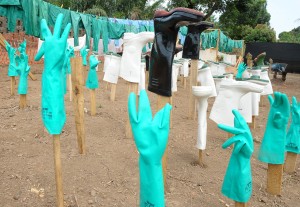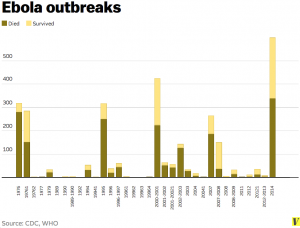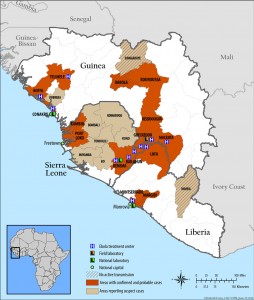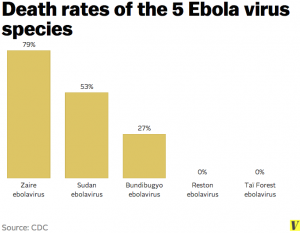Worst Ebola Outbreak Ever Gets Worse: Top Ebola Doctor Now Infected

The deadliest Ebola outbreak in recorded history is happening right now. And Reuters reports that the head Ebola doctor in Sierra Leone has contracted Ebola and is receiving medical care.
That doesn’t necessarily mean he will die, though. The death rate during this outbreak has been roughly 60 percent. And it’s an unfortunate blow in a long battle that doesn’t look like it’s slowing down.
THE CURRENT OUTBREAK HAS KILLED 632 PEOPLE AND INFECTED ABOUT 1,000
Sierra Leone is one of several countries battling the current outbreak, which is unprecedented both in the number of cases and in its geographic scope. It’s now hit three countries: Sierra Leone, Guinea, and Liberia.
And the virus — which starts off with flu-like symptoms and often ends with horrific hemorrhaging — has infected about 1,048 people and killed an estimated 632 since this winter, according to the numbers on July 17 from the World Health Organization.
Ebola is both rare and very deadly. Since the first outbreak in 1976, Ebola viruses have infected thousands of people and killed about one-third of them. Symptoms can come on very quickly and kill fast:

Journalist David Quammen put it well in a recent New York Times op-ed: “Ebola is more inimical to humans than perhaps any known virus on Earth, except rabies and HIV-1. And it does its damage much faster than either.”
So why is Ebola doing so much damage right now? Here’s a primer on what’s going on.
Why is Ebola back in the news?
Ebola tends to come and go over time.
The viruses are constantly circulating in animals, most likely bats. Every once in a while, the disease spills over into humans, often when someone handles or eats undercooked or raw meat from a diseased ape, monkey, or bat. An outbreak can then happen for several months. And then it becomes quiet again.
Ebola can completely disappear from humans for years at a time. For example, there were zero recorded cases of Ebola in 2005 or 2006.
Where is the current Ebola
outbreak?
The current outbreak started in Guinea sometime in late 2013 or early 2014. It has since spread to Sierra Leone and Liberia, including some major capital cities. It’s the first time Ebola has ever reached a state capital.
Why is this particular outbreak so deadly?
First, this outbreak concerns the most deadly of the five Ebola viruses, Zaire ebolavirus, which has killed 79 percent of the people it has infected. (The virus is called that after the formerly named Zaire, which, along with Sudan, experienced the first Ebola outbreak back in 1976.)

There are also social and political factors contributing to the current disaster. Because this is the first major Ebola outbreak in West Africa, many of the region’s health workers didn’t have experience or training in how to protect themselves or care for patients with this disease.
What’s more, an NPR story suggests that people in these countries tend to travel more than those in Central Africa (where outbreaks usually occur). That may have helped the virus disperse geographically, and it made it difficult to track down people who might be infected.
MANY OF WEST AFRICA’S HEALTH WORKERS DIDN’T HAVE TRAINING DEALING WITH EBOLA
Meanwhile, as an editorial in the medical journal Lancet noted, social stigmas and a lack of awareness may lead people to not seek medical care (or even avoid it). Another often-cited problem is that some people have had direct contact with victims’ dead bodies during funerals and preparations for burial, which can spread the disease.
A World Health Organization assessment in Liberia noted problems with tracing patients’ contacts with other people, “persisting denial and resistance in the community,” and issues with “inadequate” measures used to prevent and control infections, weak data management, and “weak leadership and coordination,” according to a statement released on July 19.
On June 23, the humanitarian group Doctors Without Borders sent out a distress call. As the only aid organization treating people with Ebola, the group said it was “overwhelmed,” that the epidemic was out of control, and that it couldn’t send workers to new outbreak sites without getting more resources.
In many ways, how well a country can deal with an Ebola outbreak comes down to basic health-care practices and public education. With enough resources poured into the effort, people should be able to contain this outbreak. So far, however, these countries are struggling.
Does Ebola really make people bleed from their eyes?
Yes. Bleeding from orifices is one of the more unusual and memorable symptoms of viral hemorrhagic fevers like Ebola. In later stages of the disease, some people bleed from the eyes, nose, ears, mouth, and rectum. They may also bleed from puncture sites if they’ve had an IV.
External bleeding can be one of the main symptoms that can help people realize they’re dealing with a case of Ebola, since other signs — first fevers and headache, then vomiting and diarrhea — can be caused by any number of illnesses. Internal bleeding can happen, as well.
But it doesn’t always happen. For example, this study of a 1995 outbreak in found external bleeding in 41 percent of cases. And bleeding didn’t correlate with who survived and who didn’t.
What actually kills people is shock from multiple organ failure, including problems with the liver, kidneys, and central nervous system.
Symptoms come on abruptly after an incubation period of 2 to 21 days. And people generally die between day 6 and 16 of the illness.
Why is Ebola so deadly?
One of the main things that seems to make Ebola viruses especially deadly is that they seem to be able to evade much of the human immune system. Among other problems, white blood cells from the immune system are often seen to die off in patients. And if the body can’t fight fully back, the virus can just keep taking over.
Scientists are still figuring out exactly how this happens, and they have several promising leads. One is that the virus is making proteins that act as decoys, interfering with the body’s ability to fight back.
How hard is it to catch Ebola?
Ebola is relatively hard to catch. Unlike measles or the flu, it’s not spreadable over the air through casual contact.
In order to get Ebola, someone must touch the blood or bodily fluids (including sweat, urine, and semen) of a person or animal who’s infected (alive or dead). People can also catch it through indirect contact with victims’ fluids, such as via bedding or medical equipment.
People generally aren’t infectious until they get sick.
This limited transmission ability is one of the main reasons why Ebola outbreaks can often be stopped within weeks or months. What it takes is public education and good health-care hygiene like patient isolation, sterilization procedures, and the use of gloves and masks.
What are the chances of Ebola spreading to the US?
The Ebola viruses known today don’t spread from person-to-person well enough to have much risk of causing a wide pandemic across several continents. The risk of Ebola coming to the US is very low.
How do you treat Ebola?
Patients are treated for symptoms, including IV fluids for dehydration. It’s important to remember that some people do survive an Ebola infection.
Hopefully, in the future there will be more options. For example, researchers are working to find drugs, including a recent $50 million push at the National Institutes of Health. And scientists are working on vaccines, including looking into ones that might be able to help wild chimpanzees, which are also susceptible to the disease.
Source(s):
vox.com
Health Freedom Alliance
Health & Wellness Foundation
CHAD Foundation
http://www.healthfreedomalliance.org
http://www.healthfreedoms.org/worst-ebola-outbreak-ever-gets-worse-top-ebola-doctor-now-infected/